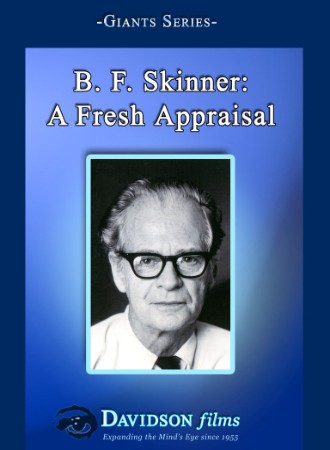
B.F. Skinner: A Fresh Appraisal 1999
Distributed by Davidson Films, Inc., 735 Tank Farm Rd, Suite 210, San Luis Obispo, CA 93401; 888-437-4200
Produced by Frances Davidson
Directed by John M. Davidson
VHS, color, 40 min.
High School - Adult
Psychology, Health Sciences
Date Entered: 11/09/2018
Reviewed by Nancy E. Frazier, E. H. Butler Library, State University of New York College at BuffaloThis film begins simply with Skinner himself quoting Bacon stating that, “nature to be commanded must be obeyed.” Through a charming mix of photographs from Skinner’s early life, examples of his mechanical inventions and famous experiments, and details about his family life, the film offers a glimpse of a humble genius in the field of behavior analysis.
The narrator, Dr. Murray Sidman, settles into a chair in a comfortable room lined with bookshelves and knick-knacks and refers to his notes about the life and work of Burrhus Frederic Skinner. Sidman refers to the influences of Darwin, Freud and Pavlov on Skinner’s work involving operant behavior and the science of behavior analysis of humans as individuals and within social systems.
Skinner’s fascination with mechanical apparatuses led him to “gadgeteering, ” the creation of devices for experiments with both lab animals and humans. The famous Skinner box was a closed environment invented for demonstrating that the repetition of any activity that produced consequences (reinforcers) showed that behavior is governed by consequences. Another famous gadget, the Teaching Machine, was based upon positive reinforcement in the learning environment.
The highlight of the film is the segment featuring Skinner’s daughters, Julie and Deborah, discussing the famous “Baby Box,” for which there was great public outcry. As Julie describes, her mother wanted help with tending to baby care with the birth of second child, Deborah. The baby box, or Aircrib, was Skinner’s way of providing a warm, safe environment for sleep and playtime for the baby. The public associated Skinner’s lab experiments with animals and the closed environment of the baby box; depicting Skinner as a cold and mechanical parent. The women share fond memories of their father, and show his simple basement study area complete with a magnifying device strung up with fishing wire over his desk to accommodate his failing eyesight.
Sidman presents an excellent blend of Skinner’s life and work and brief discussion of his major books, The Behavior of Organisms: An Experimental Analysis, Verbal Behavior, and the novel Walden Two. Skinner’s aim to improve human life through the application of behavior analysis comes through clearly in the film. Recommended - particularly for college students in Psychology.